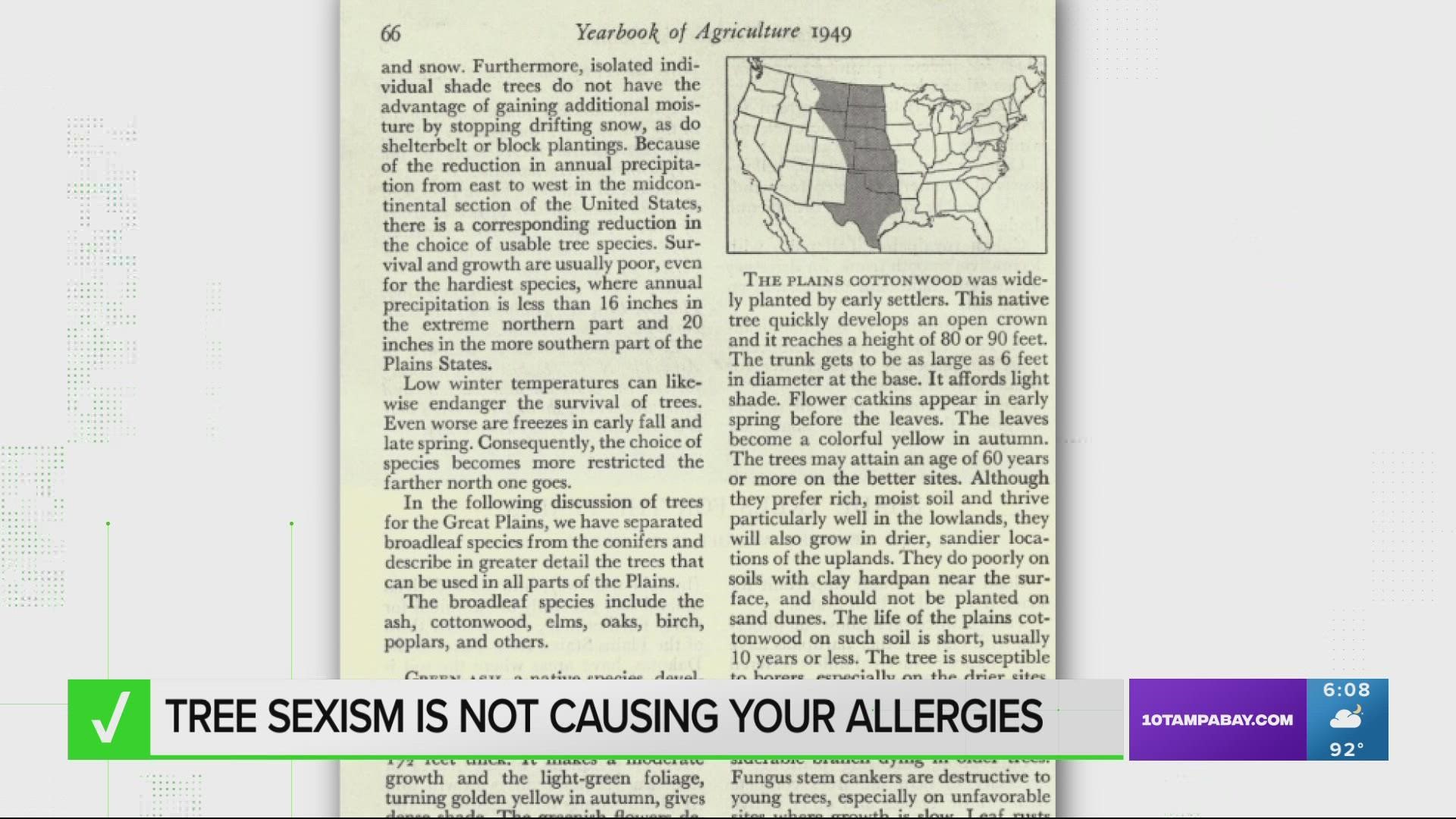FLORIDA, USA — If you feel like your allergies are getting worse and allergy season is lasting longer, it’s not just you.
Researchers said in the past three decades pollen levels have increased and allergy season has started earlier.
But can we really blame our increasingly running noses and itchy eyes on … sexism?
In various posts on TikTok, like this one, which has been shared and viewed millions of times, users explained that “botanical sexism” is why allergies and asthma across the United States have gotten worse because “landscapers and city planners thought male trees were easier to maintain.”
The theory has also been amplified on Twitter with users claiming, “it’s just one more way in which males are ruining the planet.”
THE QUESTION
Is “botanical sexism” to blame for our worsening allergies because cities plant mostly male trees?
THE SOURCES
- Marc Frank, botanist at the University of Florida
- Kim Coder, forester at the University of Georgia Warnell School of Forestry
- United States Department of Agriculture (USDA)
- Hilary Zalla, spokesperson for Hillsborough County
- Asthma and Allergy Foundation of America
THE ANSWER
The viral theory that urban landscaping is sexist and making our allergies worse needs context. Experts say the term “botanical sexism” oversimplifies trees’ complex sexual characteristics and ignores the large role climate change is having on pollen and allergies seasons.
WHAT WE FOUND
The term “botanical sexism” was first coined by horticulturist Tom Ogren. He’s written several op-eds about it over the course of the past decade and a half and has been quoted in many more reports on the subject.
Ogren argued that male trees – which produce pollen – have been favored over female trees – which produce fruit and seeds – in cities by urban planners for decades because they are easier to maintain. He based this heavily on guidance from a 1949 USDA Yearbook of Agriculture which recommended “only male trees should be selected, to avoid the nuisance from the seed.”
What Orgen doesn’t mention in citing the USDA is that it wasn’t a broad recommendation but rather specific to cottonwoods because of concerns over those seeds clogging sewers.
University of Florida botanist Marc Frank said there are two other issues with Ogren’s theory. The first is rooted in understanding the complex sexuality of trees.
“Trees have very complicated sexuality,” Frank told 10 Tampa Bay. “We think that humans are complicated, we got nothing on trees.”
Frank explained that while some trees do have distinct and separate male and female parts, most others blur the gender lines and can have various combinations.
- Dioecious trees have separate male and female parts on different trees
- Monecious trees have separate male and female parts on the same trees
- Polygamous trees can have flowers with both male and female parts on the same trees or in different combinations on different trees.
In the eastern U.S., dioecious trees – with distinct and separate male and female parts – account for just 20 percent of trees, according to a survey conducted by University of Georgia Warnell School of Forestry’s Kim Coder. That number shrinks to just five percent when accounting for all trees globally.
“So that means the remainder either have male and female flowers on the same tree or they have perfect flowers that have both male and female parts within a single flower or there’s some weird combination,” Frank said.
The second issue with Ogren’s theory, Frank explained, has to do with how trees pollinate – either through wind or with insects.
Insect-pollinated trees have larger, stickier pollen grains whereas wind-pollinated trees are going to be reasonable for your allergies.
Frank said based on his knowledge of commonly planted trees in Hillsborough County and Tampa, “only a very small subset… are both dioecious and wind-pollinated.”
A spokesperson for Hillsborough County said of all the species of trees listed on its approved tree list, just three come in a male-only/female-only variety. The county, she said, doesn’t consider whether a tree is male or female, but prioritizes other factors such as fit for soil conditions and water availability, growing space for right-of-way access and purpose.
But Ogren is correct in his assessment that seasonal allergies are getting worse for many people.
In the U.S., allergies are the sixth-leading cause of chronic illness, according to the Asthma and Allergy Foundation of America, with allergies caused by plants impacting nearly 20 million adults.
But more than ‘sexism,’ climate change, said Frank, is what's more likely increasing pollen in our cities and making our allergies worse.
Plants bloom earlier and continue to bloom longer because of warmer temperatures, he said.
Researchers say in the past three decades pollen levels have increased and allergy season has started earlier.
"In some other parts of the country Ogren’s theory may hold more water," Frank said. "But here in Florida and the humid southeast, reviewing lists of trees often planted, it doesn’t seem like there’s an overwhelming majority that fit.”
If you're looking for a list of allergy-friendly trees, here is one compiled by the Asthmas and Allergy Foundation of America.
- Apple and crab apple
- Pie cherry
- Chinese fan palm
- Female fern pine
- Dogwood
- Female English holly
- Hardy rubber tree
- Magnolia
- Pear
- Plum
- Female red maple

